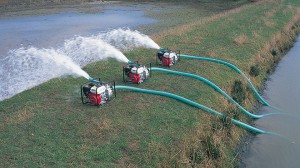Types of Pumps
De-watering pumps are used in many homes and commercial applications to remove water from an area or to force water into another location. Honda makes lightweight de-watering pumps for homeowners who need help keeping water out of basements or other areas of their property. In addition, they have general purpose pumps designed for small construction and other industrial uses. Lastly, their high-pressure de-watering pumps are designed to push water over long distances or through spray nozzles and sprinklers. Honda also has a full line of high powered industrial and commercial sized pumps for large ongoing de-watering operations.
Honda’s multi-purpose pumps are designed to handle more than just water. They are constructed with chemical resistant seals and parts for use with industrial chemicals, cleaning solvents, wastewater and more.
Lastly, Honda makes small submersible water pumps for use in ponds and irrigation purposes. These pumps can also be used for draining swimming pools.
Applications
The de-watering pump design is engineered to handle water with limited contaminates. This includes silt, muck and slime that builds up over time. However, these pumps are not able to handle solid contaminants.
Multi-purpose pumps can be used with clear water applications, but they are most often used in agricultural and industrial applications where heavy chemical content would harm a normal pump.
Construction and Industrial rated pumps are able to handle significantly more contamination than standard de-watering pumps, and can also be used for waste removal as they power through solid waste buildup. This is perfect for clearing manholes, quarries and more.
Submersible pumps share many of the features of regular de-watering pumps, but they should not be used in cases where water has heavy muck build up, and only the highest rated model numbers in this line can handle solid waste.
Maintenance
In order for your water pump to remain in good service condition, it is necessary to perform regular maintenance and inspection of the parts and systems that keep it running. This means checking clean out ports for debris and making sure that the pump is able to breathe properly. If filter screens and other parts are getting clogged, the pump may run dry and cause internal damage to itself. Inspection of the impellers and other moving parts should also be inspected to make sure no solid contaminants have damaged the blades. Lastly, pumps that are in contact with industrial chemicals should be serviced to keep seals in good condition and prevent loss of suction and power, as well as leakage.
If you are looking for OEM replacement parts for your Honda water pump or need advice on the right type of pump for your job, visit HondaLawnParts.com today. They can give you the helpful insight you need about the various water pump models to make sure you have enough pumping power to get the job done. They can also help you track down the correct parts and maintenance information for any pump in the Honda water pump line.

